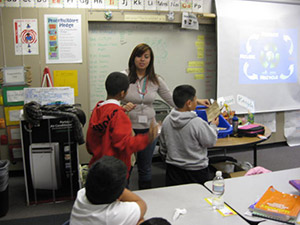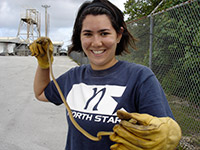Students Majoring in Environmental Systems
Hitting 'Green' Jobs Jackpot After Graduation
Susan Brown | December 14, 2009
Growing numbers of UC San Diego graduates are entering the workforce prepared to grapple with some of the thorniest environmental challenges we face.
Drawn by the opportunity to gain a broad perspective on sustainable solutions to problems and the chance to get practical experience in their implementation, undergraduates have flocked to the Environmental Systems program, one of the fastest growing majors on campus. In the eight years since the Division of Physical Sciences created the major, enrollment has grown from a handful of pioneering students to more than 200 registered this fall.
“Looking forward, I see that some of the toughest environmental questions are in the policy realm, and good decisions will require a solid understanding of the science involved,” said Jane Teranes, associate director of the program. By providing a rigorous background in both natural sciences and policy, and requiring participation in a yearlong environmental internship and research project, the Environmental Systems program turns out students who find jobs in the field. “They return to their communities and make a difference,” Teranes said.

Dominique Navarro teaches recycling to third-grade students at Las Palmas Elementary School in National City.
For many, that community is greater San Diego, where alumni are building a strong network that both contributes to the environmental health of the region and also helps graduates of the program find work. “These jobs look for adaptable people who can think fast, ask good questions and work to implement the answers they need to succeed,” Teranes said.
One of the first to graduate from the program, John Quenzer ’02 now manages projects for D-Max Engineering, a San Diego-based environmental consulting company that specializes in storm water management. “When it rains, you have water running down storm drains. It goes out to the ocean without any treatment,” he said. Quenzer helps businesses manage outdoor spaces to prevent pollutants from washing away.
Quenzer said the program prepared him well for the job, which he has held for more than five years. “The field is a good fit with Environmental Systems,” he said. “We have to interpret permits and understand policy, analysis, science and statistics. It’s interdisciplinary. You have to be adaptable.”

Among the first to graduate from the Environmental Systems program, John Quenzer ’02 helps San Diego area businesses keep pollution out of storm drains. (Photo courtesy / John Quenzer)
His job fits Quenzer as well. “There’s a practical application to what I’m doing – that’s a key thing for me,” he said. “We’re taking regulations, reports, and we’re helping people actually implement them.”
“While here, and after they graduate, students are really making a difference in the San Diego community,” Teranes said. “Likewise, the San Diego community has been really good to the environmental systems program at UC San Diego. We have established relationships with all kinds of really key people in the local environmental community who readily work with our students in internship positions and provide hands-on training year after year. This is invaluable.”
That network helped recent graduate Nicole Olmsted ’07 line up a job months before she graduated. “I went to a luncheon with Jane Teranes my senior year,” she said, “and I just happened to sit next to Lucreatria Holloway,” an environmental engineer with the Southwest Naval Facilities Engineering Command. That connection led to a position as a natural resources specialist with the Navy.
About 25 million acres of public land in the U.S. falls under Department of Defense stewardship. Much of it has become critical habitat as development encroaches. “Endangered species have been forced onto military installations because they’re not as populated and there’s not as much traffic,” Olmsted said. “It’s become home to a lot of endangered species.”

Nicole Olmsted ’07 spent three months in Guam working with the Navy, Air Force and U.S. Department of Agriculture to develop a plan to contain brown tree snakes, which have devastated island birds, from invading other Pacific Islands. (Photo courtesy / Nicole Olmsted)
Olmsted is midway through a three-year apprenticeship designed to provide an overview of the environmental unit’s operations before she takes on a permanent position. So far, she has helped with efforts to evaluate the environmental impact of proposed construction, review biological surveys and coordinate with other federal agencies to be sure that military activities don’t harm protected species.
Alicia Fouts ’05 found an environmental job soon after graduating as well. She works for the Air Pollution Control District of San Diego, where as a student she researched weekly patterns in ground-level ozone for her final-year project. Now, Fouts inspects businesses to be sure they are following regulations designed to minimize the release of damaging chemicals in the air.
“I’m like a police officer for air quality,” she said. That sometimes makes her job tough. “You walk in and nobody wants to see you. You’re the bad news of their day,” she said, though quickly adding that most business owners cooperate politely. And Fouts finds satisfaction in the improvements to air quality reported by the agency’s monitoring stations. “We are slowly, incrementally getting better in San Diego County,” she said. “I take pride in feeling I’m a part of that.”
Current students Mariesa Acosta and Dominique Navarro signed up with the Solana Center for Environmental Innovation for their final-year projects. Acosta is advising an environmental group called Project Zero Waste at San Dieguito Academy, a public high school in Encinitas. Already the students have built an 8-foot-long bin filled with red wriggler worms that will transform lunch leftovers into compost for the school’s vegetable gardens.
Navarro’s educational work takes her further south to the 10 elementary schools of National City, where more than 80 percent of the students are Hispanic. She teaches third graders the fundamentals of recycling.
“I’m Hispanic, and I had expressed my interest in working with Hispanic communities” Navarro said. “I’m from Los Angeles, and I know that a lot of communities back home don’t have the resources to bring this kind of education into the classroom.” U.S. Bank has sponsored Navarro’s internship this year.
Recycling is critical for San Diego. The city was decades behind other communities in adopting mandatory recycling. Its only landfill is scheduled to close, filled to the brim, in 2019. San Diegans throw away about 900 pounds more waste per person each year than the average Californian. Getting kids to start thinking about their trash while they’re young should help the community do a bit better, Navarro said. “It’s a value system they carry with them and can bring back home to parents and siblings.”
Read related stories on UC San Diego gravitating towards Green:

|